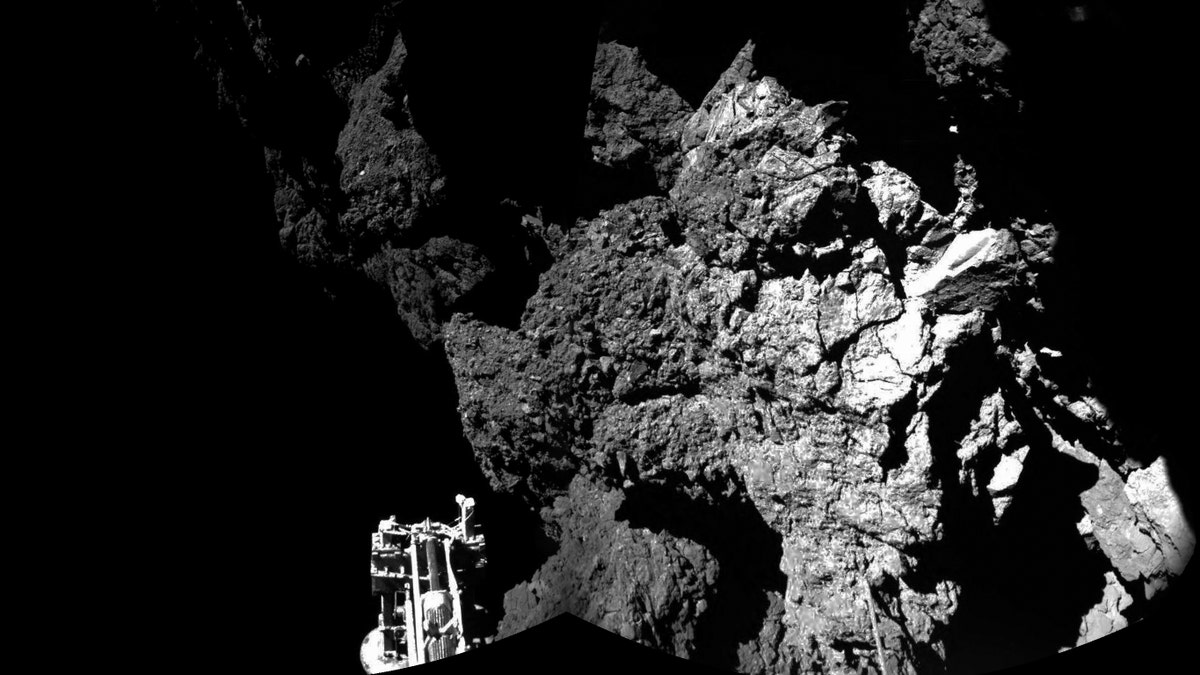
Rosetta’s lander Philae is safely on the surface of Comet 67P/Churyumov-Gerasimenko, as these first two CIVA images confirm. One of the lander’s three feet can be seen in the foreground. ( ESA/Rosetta/Philae/CIVA)
Time is running out to save the Philae space probe, which made history when it became the first to touch down on a comet more than a year ago.
The German Aerospace Center hasn’t made contact with the lander since July and now conditions on Comet 67P/Churyumov–Gerasimenko are becoming so extreme as to make it nearly impossible to bring it back to life. It's now falling below minus 292 Fahrenheit at night on the comet.
“The chances for Philae to contact our team at our lander control center are unfortunately getting close to zero,” Stephan Ulamec, Philae project manager at the German Aerospace Center, DLR, said in a statement. “We are not sending commands anymore and it would be very surprising if we were to receive a signal again.”
Related: Philae probe reaches comet, makes space history
From the moment Philae arrived on the comment in November 2014, things have not gone especially well for the probe. Because it couldn’t tether itself to the icy surface of 67P, it bounced off the surface three times before coming to rest in the shadow of a cliff.
Philae managed to conduct experiments and send data to Earth for about 60 hours before its batteries were depleted and it was forced to shut down its systems. Its location deprived its solar panels of sunlight, forcing it to enter into idle mode.
Scientists hoped the probe would wake up again last year as the comet approached the sun, when its solar panels would soak up enough light to charge the on-board battery. That happened, but for only a minute – allowing a brief burst of communication contained 300 packages of data that were relayed by the probe's mother ship Rosetta, which is orbiting the comet.
Subsequent analysis of the data indicated that the lander had in fact already woken up on April 26, 2015, but had been unable to send any signals until June 13.
Related: Philae's comet may host alien life, scientists say
Despite the improved conditions, with temperatures inside Philae reaching 32 degrees, no further contacts were made as the comet approached perihelion in August.
Mission engineers think that failures of Philae’s transmitters and receivers are the most likely explanation for the irregular contacts last year, followed by continued silence into this year.
Dust may also be covering Philae’s solar panels, ejected by the comet during the active perihelion months, preventing the lander from powering up.
Also, the altitude and even location of Philae may have changed since November 2014 owing to cometary activity, meaning that the direction in which its antenna is sending signals to Rosetta is not as had been predicted, affecting the expected communication window.
Related: Scientists confirm presence of water ice on Rosetta's comet
While hopes of making contact again with Philae is dwindling, scientists have not completely given up hope.
Rosetta will continue to listen for signals from the lander as it flies alongside the comet ahead of its own comet landing in September. The comet is currently some 138 million miles from Earth, between the orbits of Mars and Jupiter.
“We would be very surprised to hear from Philae again after so long, but we will keep Rosetta’s listening channel on until it is no longer possible due to power constraints as we move ever further from the Sun towards the end of the mission,” Patrick Martin, ESA’s Rosetta mission manager, said.
“Philae has been a tremendous challenge and for the lander teams to have achieved the science results that they have in the unexpected and difficult circumstances is something we can all be proud of,” he said.
